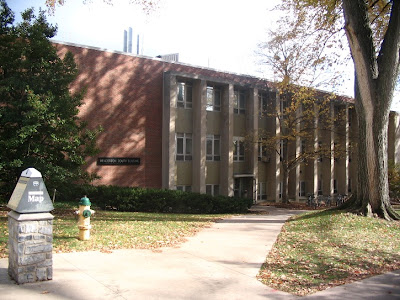This past weekend, I attended the annual conference of the
National Council on Family Relations (NCFR), which this year was held in Pittsburgh.
As with any metropolis, there are several colleges and universities in the Steel City, the two most nationally prominent of which are the
University of Pittsburgh ("Pitt") and
Carnegie Mellon University. Pitt and CMU are adjacent, just a stroll up or down Forbes Avenue from each other.
Taking advantage of the two schools' proximity to each other, I took the
bus from where I was downtown to the Oakland section of Pittsburgh (
here and
here), which is home to the two universities plus other cultural attractions.
I have friends and colleagues at the two schools, so I was able to visit with them, as well as go sightseeing and take pictures.

Let's start with the most prominent landmark of this -- or virtually any other -- academic neighborhood, the
Cathedral of Learning, on the
Pitt campus. The Cathedral includes a number of interesting features, including the Nationality Rooms. According to the linked Wikipedia entry:
Standing at 535 feet (>163 m), the 42-story Late Gothic Revival Cathedral is the tallest educational building in the western hemisphere and the second tallest educational building in the world.
Close by is the
Center for American Music and Stephen Foster Memorial, which given
my interest in songwriting, I had to go see!
I also took a picture of a Pitt entrance sign. Given the grayness of the weather and my distance from the sign, the shot didn't come out too clearly. My attempts at cropping and playing around with the brightness may have helped a little, but not completely.

Another neat feature of the Pitt campus is that it was the home of the Pittsburgh Pirates' old baseball stadium,
Forbes Field (in use from 1909-1970).
The actual home plate from Forbes Field is preserved under glass in its original location -- which happens now to be indoors, inside
Wesley Posvar Hall. Also represented on the campus is a segment of the outfield fence, again in its original location. I was getting ready to take a picture of home plate, when someone standing nearby asked if I wanted her to photograph me standing by the plate. I said, "Sure," but made it clear I wanted her to get the plate in the picture, not so much me. As seen below, I had to crouch down pretty low in my pretend batter stance. After thanking my photographer, I then walked out to the outfield marker.

All in all, among the schools depicted on this website, I would say Pitt was most similar to Boston University, in terms of the urban feel and blending of campus and commercial property.
Carnegie Mellon, a smaller private institution, had a much different feel. There is a lot of green space and a more insular atmosphere, by my perception at least. The following two pictures are of CMU. In the second one, you can see Pitt's Cathedral of Learning in the background.


Right in between the two campuses is Craig Street, a hub of restaurants and other college-town amenities. I had lunch there with my friend from CMU, at a vegetarian-friendly place called
Eat Unique.
The Pitt-CMU-Oakland area would probably have to be considered one of the livelier academic complexes you'd find in the United States.

.jpg)



















































